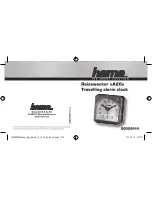
About Kieninger ...
Kieninger is the oldest existing manufacturer of mechanical
clock movements for grandfather, wall and mantel clocks in
the world.
The Kieninger clock factory was founded 1912 by Joseph
Kieninger at Mönchweiler in the Black Forest, right in the
heartland of the German clock industry. In 1917 the factory
moved to Aldingen, a charming village only a few miles away
from Mönchweiler and the foot hills of the 'Schwäbische Alb'.
Still in Aldingen the company today occupies a modern
54.000 square feet manufacturing facility, newly constructed
in 1991, and employs about 100 dedicated and highly skilled
workers.
Serving customers in more than 60 countries around the
globe Kieninger's single largest export market traditionally
remains the USA.
Since 1993 Kieninger has been part of the Howard Miller
Group (USA), the largest manufacturer of grandfather clocks
in the world.
From its very beginning Kieninger has stayed with its
traditional concept: the manufacture of technically advanced,
high quality mechanical movements and clocks. For many
decades this has been the successful formula and it is to no
suprise that Kieninger today is known for its craftsmanship
and the manufacture of products of the highest quality.
Kieninger clocks are counted among the classics of the
industry and some are already shown in the internationally
famous clock museum in Furtwangen, Germany. For the
unique tubular movement of the model 0087, Kieninger
received the presigeous design award from the German
copper and brass industry in 1988.
Only a limited quantity of handcrafted clocks is manufactured
every year and Kieninger is determined to continue to offer
only unique and individually designed clocks of the highest
quality to its customers.
Introduction
Aside from the clock case all mechanical clocks consist of 5
basic components: The drive system with an energy source
(weight or spring) and the respective winding mechanism; a
time display comprising the dial and the hands (hour and
minute hand and in some cases special displays like second
hand, moon phase and date); the regulator (constant-speed
controller); the escapement and the clock gears. Depending
on type of movement additional trains of gears may control
the hour strike and the quarter hour (melody) chime. The
clock movement combines clock gears, additional gear
train(s), escapement and depending on the type of movement
an integrated regulator (balance wheel), drive system(s) and
chime modules in one unit.
The hour strike and quarter hour chime sounds are created by
a series of hammers hitting gong rods, tubes or bells of
different length and/or size. Each size or length rod, tube or
bell produces a different sound. The chime melodies are
generated by controlling the sequence and rhythm that each
hammer hits a corresponding rod, tube or bell through
different chime drums.
Depending on type of movement the pendulum (external
regulator) and the weights or springs are additional
components of your clock and critical for the correct operation
of the clock movement.
Pendulums of different length swing at different speeds. By
changing the effective length of the pendulum, one has the
ability to regulate and adjust the running speed (time keeping)
of the clock. Changing the effective length of the balance
wheel spring functions likewise.
The time keeping and the one or two strike/chime modules
are driven by separate weights or springs. The weights or
springs provide power to the hour strike (left), time (center),
and, where applicable, quarter hour chime (right). Without the
power of these weights or springs, the clock would not
operate. For weight driven movements and depending on
movement and features of the clock each weight is different
and must be properly hung from the movement to ensure
proper operation. Weights or springs should be raised or
wound at least every 7 days or the clock will stop.
12













































